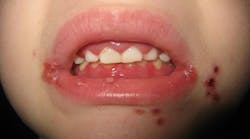Catering to kids
How to promote oral health and overall wellness
Every child thinks life is tough. While our parents used to tell us they walked uphill five miles to school - both ways - children’s issues today mimic those of adults and create significant health risks at an early age.
A quick search on the Internet reveals startling statistics for children and adolescents regarding tobacco use, teen pregnancy, obesity, diabetes, depression, and suicide. Dental professionals who used to focus on plaque removal to prevent gingivitis and decay may now have to deal with tobacco use, increased soda consumption, and Type II diabetes.
Now is the time to include multiple assessments for decay and periodontal disease in children and adolescents, in addition to poor plaque control. Dental practitioners should identify risks for overall health complications and recommend appropriate therapy or referral to promote wellness.
Tobacco - Nearly 6,000 children younger than 18 start smoking each day. Of those, 2,000 become regular smokers. That is nearly 800,000 annually.
In the United States, close to 4.5 million adolescents smoke cigarettes. If there is no change in this trend, it is projected that 6.4 million will die prematurely from a smoking-related disease.1 While there has been a decrease in the number of adolescents who use smokeless tobacco, it is still high with 11 percent of boys and 2.2 percent of girls in U.S. high schools. The rate for boys has declined while the rate for girls has slowly increased since 1999.2
Tobacco use in children and adolescents produces the same health complications as seen in adults including respiratory, cardiovascular, and cancer.1,3 Dentists should conduct oral cancer screenings on children and adolescents. Oral signs of smokeless tobacco use include gingival recession and leukoplakia1,3
Obesity - The significant rise in obesity in the United States has been reported recently in the media. Most alarming, obesity in children and adolescents has reached epidemic proportions. Being overweight for children and adolescents is defined as BMI-for-age at or above the 95th percentile of the CDC Growth Charts4 In 1999, 13 percent of children ages 6 to 11 and 14 percent of adolescents ages 12 to 19 were overweight. This represents nearly a three-fold increase in the past two decades.
Similarly, NHANES data from 1999 to 2002 reveals that 16 percent of children and adolescents ages 6 to 19 were overweight, indicating there is no evidence that obesity is decreasing. Expecting “chubby” kids to reach a normal weight once they grow taller is no longer accepted, as new data indicates that overweight adolescents have a 70 percent chance of becoming overweight adults. This increases to 80 percent if one or more parent is overweight.
Along with adults, children and adolescents are at risk for developing Type II diabetes, hypertension, and heart disease. Studies show the growing number of American children considered overweight or obese has been accompanied by a rise in blood pressure levels, cholesterol, triglycerides, and insulin resistance. The relationship between periodontal disease and obesity was recently studied, and the results demonstrate a significant association between obesity and periodontal infection among individuals ages 18 to 24.
Obesity is caused by a lack of physical activity, unhealthy eating habits, or both. A recent study of sixth and seventh graders found that time spent watching television and soft drink consumption were significant factors for obesity. The increase in soft drink consumption is well documented. An estimated 40 percent of preschoolers drink eight ounces of soda each day. Fifty years ago, soft drink consumption was two 12-ounce cans per week. In 1997, that rose to two 12-ounce cans per day. 13 Most soft drinks contain one or more acidulants. In vitro studies have shown that soft drinks with a low pH can cause dental erosion in deciduous and permanent teeth.
Adverse pregnancy - Teenage pregnancy continues to be a problem in the United States, but the rate dropped 5 percent in 2002. Nevertheless, there are still 43 births per 1,000 teenagers ages 15 to 19. The incidence of preterm birth, or PTB, and low birth weight, or LBW, deliveries continues to increase among teenagers who fall below the federal poverty level, have less than 12 years of education, and who receive inadequate prenatal care.15,16
Evidence is growing regarding the relationship between PTB/LBW infants and periodontal infections, although there is no evidence to show a cause-and-effect relationship. This is supported by a recent study that demonstrated an increased risk of spontaneous preterm birth, but found no association between periodontal disease and markers of inflammation in the upper genital tract at the time of delivery.17 Contrary are two intervention studies that showed periodontal therapy significantly reduced the rate of PTB/LBW. The relationship between periodontal disease and PTB/LBW infants in adolescents is unknown, but an increase in gingivitis and other oral complications may occur.18,19
Teen depression One in five children and one in eight adolescents have some sort of mental, behavioral, or emotional problem. Seventy percent of these young people do not receive intervention, and parents - even good communicators - often don’t recognize the signs of depression in their children. Evidence indicates that depression onset is occurring earlier in life than in past years. Depression in children and adolescents often occurs with other disorders such as anxiety, substance abuse, and diabetes.20,21
Suicide is the third-leading cause of death among adolescents and young adults ages 15 to 24, and the sixth among children ages 5 to 14. Signs of depression that may be noticed when taking or reviewing a medical history include:20,21
Non-specific physical complaints such as headaches, muscle aches, and stomachaches
substance abuse such as smoking
change in weight
complaints of insomnia or hypersomnia
restlessness or irritability
Intervention can be effective.20 Recognizing when a child or adolescent is chronically depressed, especially during the teen years, is a challenge for parents and health care providers alike.
Impact on assessment and treatment - The paradigm shift toward comprehensive assessment promoting overall wellness in the dental office provides an opportunity to screen for dental problems plus other conditions affecting children and adolescents. It may not be easy to address obesity or pregnancy with a parent and adolescent, but a comprehensive medical and dental history will help identify risk factors. The role of the dental professional is to assess, ask probing questions, document, and recognize when referral may be necessary.
Treatment plans for children and adolescents may include smoking cessation, nutritional counseling, or diabetes testing or counseling. Blood pressure assessment should be the standard of care for everyone, regardless of age.
Encouraging children and adolescents to ask questions and help make decisions regarding therapy and self-care can be rewarding. There are often several easy choices, and a little empowerment can raise self-esteem and, therefore, compliance. Even though the statistics are daunting, many children and adolescents present with typical oral conditions such as gingivitis and caries. Education at an early age about the impact of oral disease on overall health and development of good self-care habits can lead to a lifetime of good oral health.
Children and adolescents are technology savvy, so power products often motivate them. Power toothbrushes and flossers are ideal for improving biofilm removal, and dental water jets have proven effective with orthodontic appliances, gingivitis, or in people with diabetes. Fluoride is the standard of care for caries prevention. Recent studies have shown that regular use of products containing xylitol such as chewing gum or breath mints may significantly reduce the incidence of caries in adults and children.31
Dental professionals play a key role in the promotion of overall wellness and oral health, regardless of etiology or risk factors. Children often need to hear from sources other than their parents about issues such as smoking or limiting soft drinks. Helping children improve their lives can be rewarding and can help ensure a population with a long, healthy future.
References
1. American Lung Association. Adolescent smoking statistics. November 2003. Accessed August 5, 2004.
2 National Center for Chronic Disease Prevention and Health Promotion. YRBSS: Youth Online Comprehensive results. http://apps.nccd.cdc.gov/yrbss/QuestYearTable.asp Accessed August 5, 2004.
3 National Cancer Institute. Cancer Control & Population Sciences. Smokeless tobacco. http://dccps.nci.nih.gov/tcrb/less_default.html Accessed August 13, 2004.
4 National Center for Health Statistics. Obesity still on the rise, new data show. www.cdc.gov/nchs/pressroom/02news/obesityonrise.htm Accessed August 5, 2004.
5 United States Department of Health and Human Services. The Surgeon General¿s call to action to prevent and decrease overweight and obesity. www.surgeongeneral.gov/topics/ovesity/calltoaction/fact_adolescents.htm Accessed August 5, 2004.
6 National Center for Health Statistics. Prevalence of overweight among children and adolescents: United States, 1999 - 2000. www.cdc.gov/nchs/products/pubs/pubd/hestats/overwght99.htm Accessed August 5, 2004.
7 Hedley AA et al. Prevalence of overweight and obesity among U.S. children, adolescents, and adults, 1999-2002. JAMA 2004; 291:2847-2850.
8 American Academy of Pediatrics Policy Statement: Prevention of pediatric overweight and obesity. Pediatrics, 2003; 112:424-430.
9 Muntner P et al. Trends in blood pressure among children and adolescents. JAMA 2004, 291: 2107-2113.
10 Lambert M et al. Insulin resistance syndrome in a representative sample of children and adolescents from Quebec, Canada. Int J of Obesity 2004; 28:833-841.
11 Al-Zahrani MS, Bissada NF, Borawski EA. Obesity and periodontal disease in young, middle-aged, and older adults. J Periodontol 2003; 74:610-915.
12 Giammattei J et al. Television watching and soft drink consumption: Associations with obesity in 11-13 year old school children. Arch Pediatr Adolesc Med 2004; 157:882-886.
13 Shenkin JD, Heller KE, Warren JJ, Marshall TA. Soft drink consumption and caries risk in children and adolescents. Gen Dent 2003; 51:30-36.
14 Heller K, Burt B, Eklund S. Sugared soda consumption and dental caries in the United States. J Dent Res 2001; 80:1949-1953.
15 Martin JA, et al. Births: Final Data for 2002. National Vital Statistics Reports 2003; 52:1- 102. www.cdc.gov/nchs/data/nvsr50/nvsr50_5.pdf. Accessed July 2004.
16 March of Dimes. Perinatal Profiles: Statistics for monitoring state maternal and infant health. 2003 Edition. www.marchofdimes.com Accessed July 2004.
17 Goepfert AR et al. Periodontal disease and upper genital tract inflammation in early spontaneous preterm birth. Obstet Gynecol 2004; 104:777-783.
18 Lopez NJ, Smith PC, Gutierrez J. Periodontal therapy may reduce the risk of preterm low birth weight in women with periodontal disease: A randomized controlled trial. J Periodontol 2002; 73:911-924.
19 Jeffcoat et al. Periodontal disease and preterm birth: Results from a pilot intervention study. J Periodontol 2003; 74:1214-1218.
20 About Teen Depression. www.about-teen-depression.com. Accessed November 2, 2004.
21 National Institute of Mental Health. Let¿s talk about depression. www.nimh.nih.gov/publicat/letstalk.cfm. Accessed November 2, 2004.
22 Barnes C et al. A comparison of a Waterpik dual motor power toothbrush and a manual toothbrush in affecting interproximal bleeding reduction and dental biofilm accumulation. J Clin Dent 2003; 14:49-52.
23 Zimmer S et al. Clinical study of the effectiveness of two sonic toothbrushes. J Clin Dent 1999; 11:24-27.
24 Heasman PA et al. Power toothbrushes: a review of clinical trials. J Clin Periodontol 1999; 26:407-420.
25 Jahn C. Evidence for self-care products: Power brushing and interdental aids. J Prac Hyg 2004; 13:24-29.
26 Warren PR et al. Safety, efficacy and acceptability of a new power toothbrush: A 3-month comparative clinical investigation. Am J Dent 2001; 14:3-7.
27 Shibly O et al. Clinical evaluation of an automatic flossing device vs. manual flossing. J Clin Dent 2001; 12:63-66.
28 Flemmig TF et al. Adjunctive supragingival irrigation with acetylsalicylic acid in periodontal supportive therapy. J Clin Periodontol 1995; 22:427-433
29 Al-Mubarak S et al. Comparative evaluation of adjunctive oral irrigation in diabetics. J Clin Periodontol 2002; 29: 295-300.
30 Burch JG et al. A two-month study of the effects of oral irrigation and automatic toothbrush use in an adult orthodontic population with fixed appliances. Am J Orthod Dentofac Orthop 1994: 106:121-126.23.
31 Peldyak J. Kauko KM. Xylitol for caries prevention. J Dent Hyg 2002; 76:276-285.
Ms. Lyle has 25 years of dental experience, including faculty appointments, clinical practice, and research. She is currently employed by Waterpik Technologies as the manager of professional marketing and education. You may reach her at [email protected].



